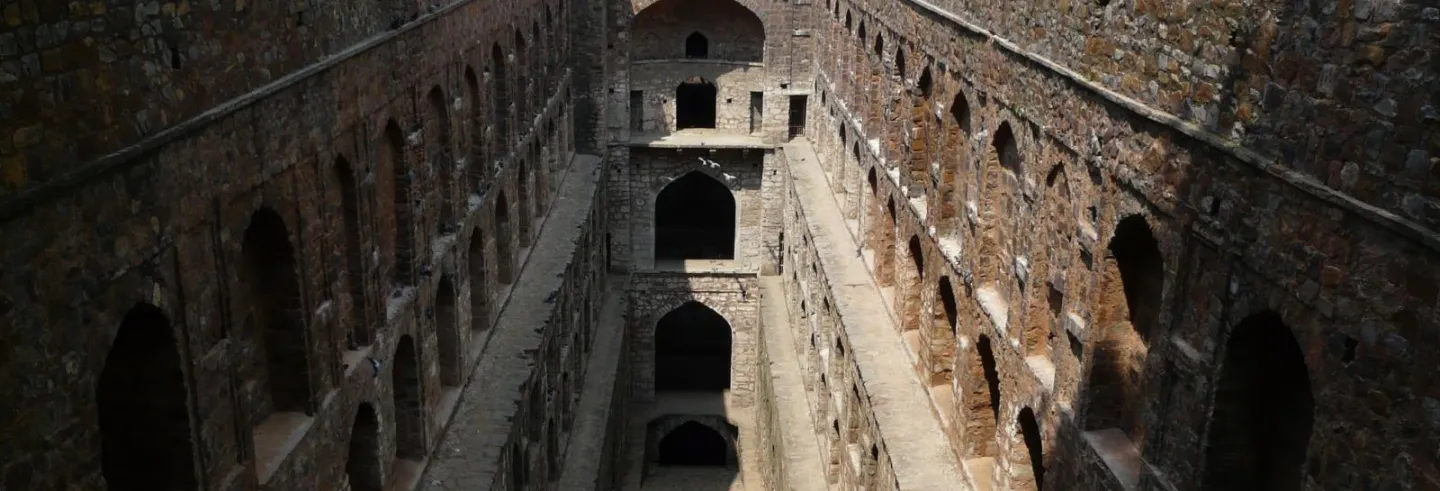The Delhi metro network has created new mobilities and hubs, transforming the urban landscape for those who travel within it and for those whose neighbourhoods were transformed by stations and elevated and submerged lines. In this article, I want to explore the subterranean transformations effected by the metro’s construction.
The construction of the metro system, and especially the underground portions of the network, necessitated subterranean destruction on an unprecedented scale. Although significantly more expensive (around two and a half times as costly), in the initial phases of the metro’s construction, underground tunnels were the preferred, indeed only viable, option for densely occupied areas. Tunnel boring machines (TBMs), which cause relatively little disturbance of the subterranean layers around the tunnel, burrowed the majority of tunnels between stations. The TBMs churned and displaced millions of tonnes of stone, rock, and sand.
Beneath the surface of any living city are compacted and fragmented layers of abandoned and superseded occupation, lost and forgotten objects and remains. Curiously, during the construction of the Delhi metro, only one set of “archaeological remains” were ever unearthed – those now guarded in the closed Subhas Chandra Park near the walls of the Red Fort.
The custody of Delhi’s heritage, in all its variety and richness, lies with a constellation – perhaps even an embarrassment – of agencies. Delhi’s Masterplan 2021, first published in 2007 and subsequently amended in 2010 and 2021, assigns the protection of just one category – “Delhi’s Built Heritage” – to six bodies. They are the Archaeological Survey of India (ASI), the Government of the National Capital Territory of Delhi (GNCTD), State Archaeology Department, the New Delhi Municipal Corporation (NDMC), the Cantonment Board, and the Delhi Development Authority (DDA).
Curiously, during the construction of the Delhi metro, only one set of “archaeological remains” were ever unearthed.
The complex fabric of jurisdictions is augmented by the creation of the Delhi Metro Rail Corporation’s (DMRC) “influence zones”, areas of 11 metres to each side of any metro structure in which any building work is forbidden without a “no objection certificate” from the DMRC. I want to attempt to examine how those custodies over the fragments disturbed by the metro’s construction operate, and facilitate the integration of city’s past into the metro network.
The construction of the metro system in Delhi began in October 1998. Almost 14 years later, a Heritage Impact Assessment was conducted, between July and October 2012. The Heritage Impact Assessment was limited to a section of the Violet Line, nicknamed the Heritage Line – a 5.27-km long tunnel that runs from ITO to Kashmere Gate. The Heritage Impact Assessment began its work a year after construction on the Violet Line began and, on the basis of its report, completed in November 2012, a no objection certificate was issued by the National Monuments Authority in January 2013.
Heritage Impact Report
The investigation was led by conservation architect and activist Nalini Thakur, then at the School of Planning and Architecture, and included contributions from the fields of planning, architecture, geography, and archaeology (SPA 2012). The report’s detailed conclusions fall, broadly, into three categories—risks, opportunity, and responsibility.
The metro line was designed to pass in proximity to a series of famous monuments such as the Red Fort and the Jama Masjid and through some of the densest, and oldest, urban landscapes in the city. The report counted 175 heritage structures in the area that the line would pass beneath, 18 protected by the ASI as National Monuments and 148 under the jurisdiction of the Delhi State Archaeological Department.
Beyond, or rather around, this list of isolated structures, the report urged an integrated, inclusive approach to protection and mitigation during the construction of the line between Delhi and Kashmiri Gates, which would pass under an area of extraordinary archaeological richness. It would destroy the subterranean layers beneath it, and the report summarised the potential risks in very broad terms, urging “extreme caution.” It recommended the maintenance of a 100-metre “buffer zone” and carefully ascertaining “the type, state and depth of the foundation of […] important heritage structures.”
The Heritage Impact Report was emphatic on the question of responsibility for both the protection of existing monuments and the archaeological research that would be necessitated by the metro excavations.
The Heritage Impact Report, while urging caution, also welcomed the construction of the metro as offering an unprecedented opportunity for the long overdue archaeological exploration of the surface and subterranean remains of the high-Mughal, late-Mughal, and colonial periods in the Old City (27). It said, “The construction of the underground metro tunnel presents an opportunity to accomplish this unfinished task.” In particular, the metro’s construction would allow an exploration of the widespread and brutal destruction of large areas of Shahjahanabad by the British in retaliation for the rebellion in 1857.
The report was emphatic on the question of responsibility for both the protection of existing monuments and the archaeological research that would be necessitated by the metro excavations. It contains a number of pointed statements about the “statutory and technical mandate” of the ASI. The report went further to consider the observable, operational “lacuna” that existed between the ASI, the DMRC, and “other agencies” (presumably, the National Monuments Authority, the DDA, and the Delhi Urban Arts Commission) responsible for urban infrastructural planning in Delhi. Without coordination between these bodies, the report warned, “conclusive mitigation measures are hard to achieve.”
The Heritage Impact Report recommended that ground penetrating radar surveys be carried out and that rescue archaeology be undertaken, where necessary. “In case archaeological remains are uncovered during the tunnelling, ASI should be intimated about the findings immediately and ‘Rescue Archaeology’ work should be undertaken in accordance with international best practices.” For this, it also recommended that the ASI “hire professional archaeologists, agencies, academic institutions with the relevant expertise and experience to facilitate this work."
The Heritage Impact Report, recognising the likelihood that submerged material culture would be disturbed by tunnelling operations, recommended that any objects discovered during the tunnelling should be collected, stored, and interpreted. The no objection certificate issued by the National Monuments Authority in January 2013 had five stipulated conditions, four of which specified and required the involvement of the ASI as a key partner in monitoring the potentially rich “archaeology, especially medieval archaeology” of the old city.
In a series of conversations […] senior officers of the ASI and the Delhi State Archaeological Department have maintained that there were no archaeological implications to any of the metro excavations.
The DMRC was charged with creating “small museums or display units for any salvaged/rescued archaeology.” Both the Heritage Impact Report and the National Monuments Authority were emphatic that, first, existing monumental architecture should not be damaged, and, second, the excavations at stations and TBM entry points should be carefully monitored in case noteworthy stratified rocks were unearthed by the excavations.
Despite the recommendations of the Heritage Impact Report and the terms of the National Monument Authority’s no objection certificate, no archaeological excavations were carried out during the construction of the metro under the Old City and there is no evidence that any objects were retrieved. In a series of conversations over the last two years, senior officers of the ASI and the Delhi State Archaeological Department have maintained that there were no archaeological implications to any of the metro excavations.
This apparently implausible position does resonate with the current regulations. The cardinal principle of 100 metres distance between construction and protected monuments only applies, or can only be applied, to known, registered monuments. The regulations do not account for the existence of remains as yet unknown. There is also significant ambiguity over whether the wording of the 100-metre regulation applies equally below, as it does above, the ground. The buffer zone, therefore, cannot be used to predict or protect the unearthing of previously submerged remains.
Akbarbadi Mosque
The idea of the Akbarbadi Mosque drew together the realms of archaeological inquiry and urban life. The remains, unearthed in the summer of 2012, prompted the DMRC to move the planned Jamma Masjid Station by 25 metres, leaving the unearthed, and increasingly controversial, remains in Subhas Chandra Park. The unearthed structural fragments were no different from any number of the submerged structural fragments that were disturbed and displaced by tunnelling and constructing stations.
Their distinguishing feature was that they were noticed, and quickly became the subject of local rumours. The Heritage Impact Report conferred a status to the remains and, perhaps unwisely, made them emblematic of the significance of all potential emergent materials—“The destruction of underground archaeological heritage undermine the values of the city, as witnessed during the recent incident of the Akbarabadi Mosque.”
The Akbarbadi Mosque was identified and brought to life by the animation of local politics. It owed nothing to archaeological enquiry, knowledge, or interpretation. The ASI has undertaken no exploration or excavation of the site. The Akbarbadi Mosque was created by narratives that circulated on the surface, first through local rumours, which were later amplified in the larger political arena and the press. The remains now sit, covered and guarded, in the closed and neglected park.
The DMRC, perhaps uniquely amongst the various agencies involved, has managed to integrate the carefully un-named remains into its narration for the public without any reference to political, religious, or judicial controversy.
The strength of the bond created between the remains and the Akbarbadi Mosque by local rumour, politics, the Heritage Impact Report, and by the judicial process, under which the remains are now submerged, make any meaningful archaeological research unlikely and, arguably, unwise.
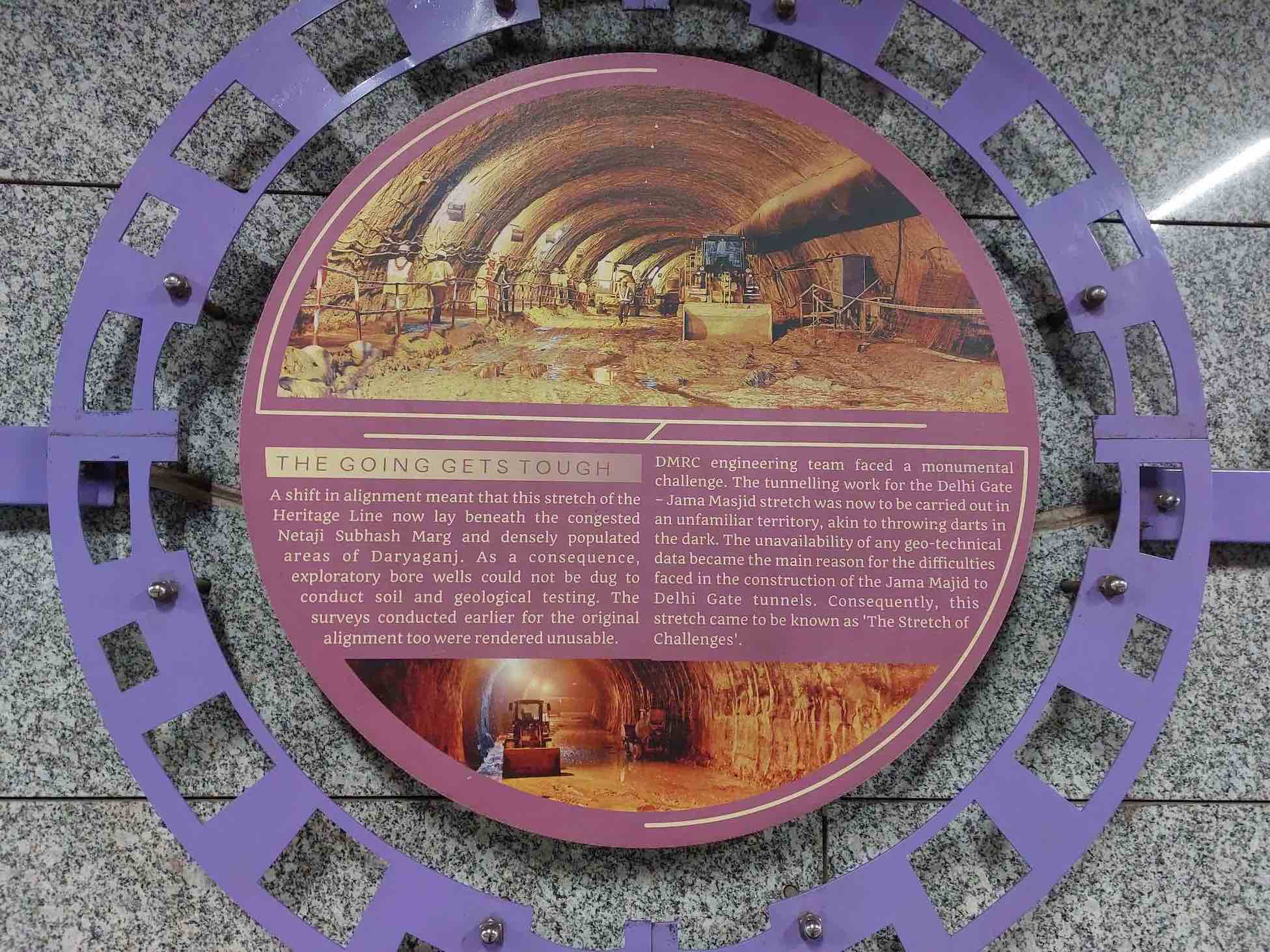
An installation of panels (Image 1) at the Jama Masjid station provides a candid, if upbeat, account of the excavations in the area. While tactfully not naming the remains as the Akbarbadi Mosque, their unearthing during the initial excavations for the Jama Masjid Station is narrated, somewhat romantically and inaccurately given its subsequent suffocation in political controversy and judicial procedure, as 'An Old Relic Breathes Again' (Image 2). The DMRC, perhaps uniquely among the various agencies involved, has managed to integrate the carefully un-named remains into its narration for the public without any reference to political, religious, or judicial controversy.
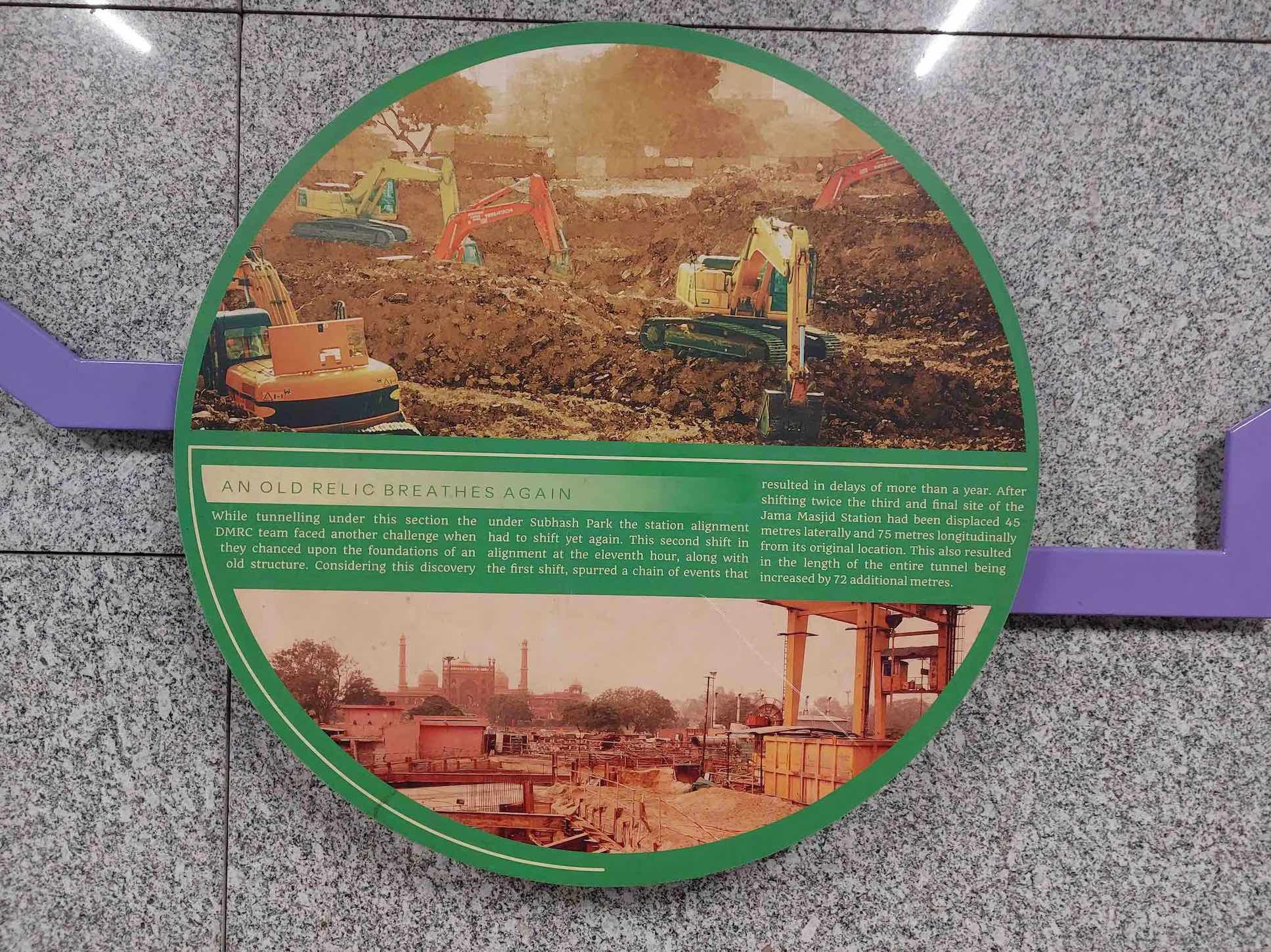
The tunnels between Delhi Gate and the Jama Masjid were moved twice, once to maintain a “safe distance” from the Sunehri Masjid and again after the discovery of the “Akbarbari Mosque” remains (Gadgil, Garg, and Kumar) describe the challenges faced. The public information panels at the Jama Masjid station celebrate the re-routed tunnelling that took place in the absence of the kind of geotechnical information required by both the Heritage Impact Report and the National Monuments Authority.
The depth of the tunnels in the section of the metro under the Old City varies from its shallowest at 16.5 metres depth at Kashmiri Gate and Delhi Gate stations to almost 16 metres deep at the Lal Qila station. The line passed beneath an area of dense population (and not, as previously planned, open ground). Two thousand people were temporarily re-housed during the construction of the tunnels from the Jama Masjid station to Delhi Gate.
The “type, state and depth of the foundation of […] heritage structures” were not established, as per the National Monument Authority’s stipulations and no attempt was made to monitor the subterranean layers beneath the city as they were churned by the TBMs. Work of this kind would have required the integration of constant archaeological survey and monitoring and inevitable interruptions of tunnelling.
Since no ground survey was carried out, the line became known by the DMRC as the “Stretch of Uncertainties” or, according to the Jama Masjid panel, the “Stretch of Challenges.” In a revealing comparison, the tunnelling was deepened between Janpath and Mandi House, an area far less likely to contain submerged archaeological materials, because the foundation depth of the modern high-rise construction nearby was documented.
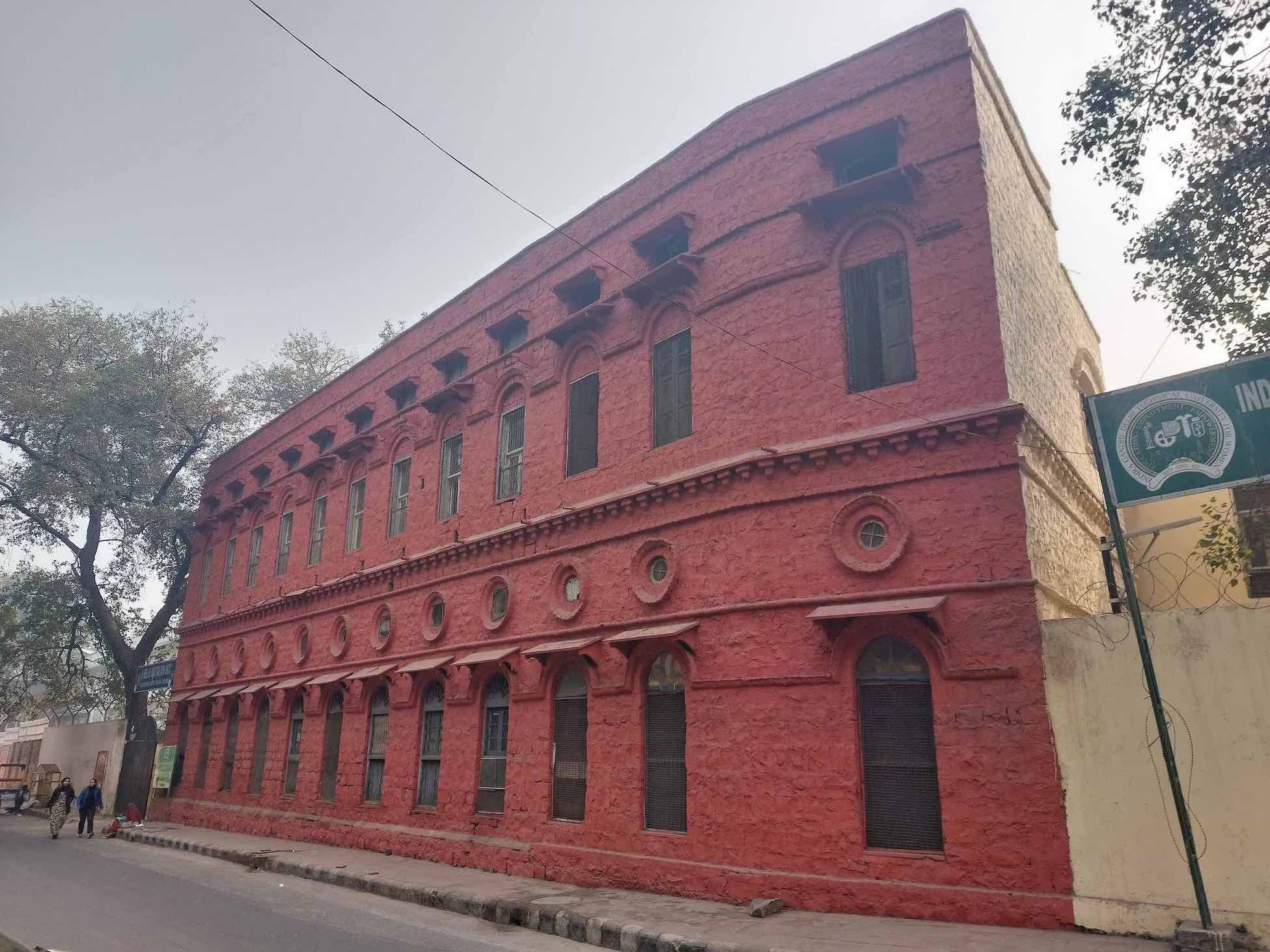
The DMRC has pursued a determined and remarkable approach of transparency. Despite the excellence of the engineering works, in a dense urban environment, structural damage was inevitable. At 4 pm on 20 April 2015, tunnelling resulted in the collapse of the NCC building (adjacent to St James Church at Kashmiri Gate) after power, and therefore equalising pressure in the tunnel, was lost. The building was rebuilt by the DMRC in its original design with impressive rapidity in the months after the collapse (Image 3).
New challenges
The DMRC has been committed to public relations and a desire to create selective associations between the city’s heritage and the fabric of the metro stations. The metro makes deliberate and conspicuous use of the icons and symbols of Delhi’s past. Silhouettes of the city’s most remarkable monuments are moulded onto the external facing of the blue line, rather ironically only visible to the passengers travelling by car on the Noida Link Road on either side.
The design of several metro stations integrates proximate and prominent institutions and monuments into the station through photographs, information panels, and artwork. In a useful reminder that heritage is never a stable commodity, a mural at the Khan Market metro station, opened in 2010, depicts the Hall of Nations, a landmark of modernist architecture completed in 1972 that was demolished in 2017 (Image 4). The mural also depicts a Rs 500 note, a denomination dispatched to the realm of heritage by demonetisation in 2016.
The ASI’s inflexible custody can only gradually erode as its reach fails and the disparity between its original, imperial remit falls further from the living, dynamic realms of India’s heritage.
The massive excavations needed to create the Delhi metro network depended on the permissions granted through a complex set of bureaucratic mechanisms, of regulations, stipulations, and reports. However, these mechanisms have little purchase in the living, dynamic landscapes of the city that they are designed to understand and protect. The ASI, a vast institution with the capacity for research, conversation, and documentation on a sub-continental scale, is now so encumbered by bureaucratic regulation that it has lost the ability to respond to new challenges.
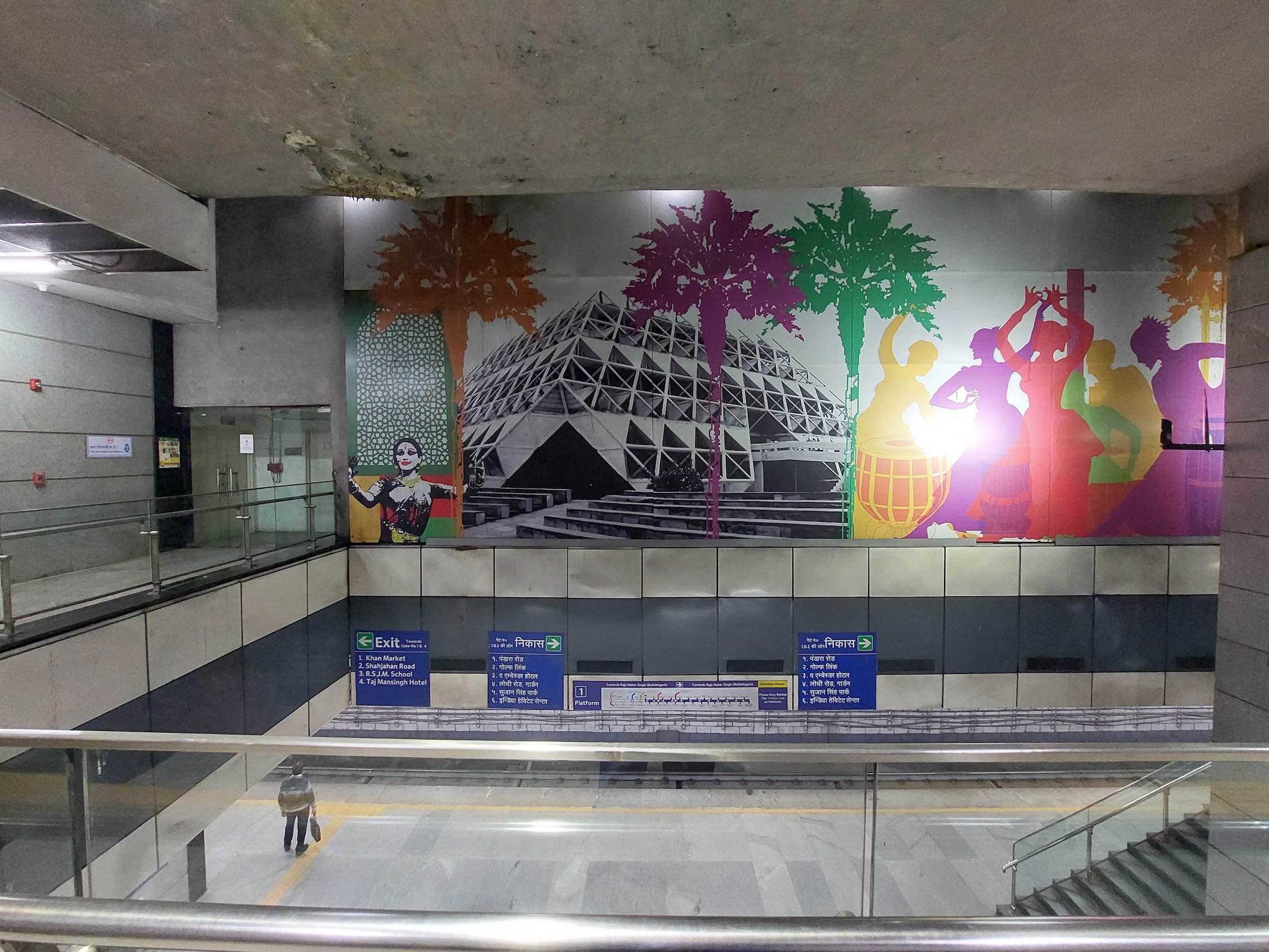
The template for this bureaucratic matrix was created at the start of the 20th century by an imperial bureaucracy to generate and then protect a set of known, notified monuments. As recent reports have indicated, this inflexible custody can only gradually erode as its reach fails and the disparity between its original, imperial remit falls further from the living, dynamic realms of India’s heritage.
Infrastructural development will always unearth surprises – perhaps ostensibly physically unremarkable and ambiguous – that may delay the progress of new construction, but which have the potential to upend our understandings of our past. The submerged pasts of Delhi are not to be seen as impediments to the present, but as opportunities.
Deborah Sutton teaches modern history at Lancaster University, UK.

